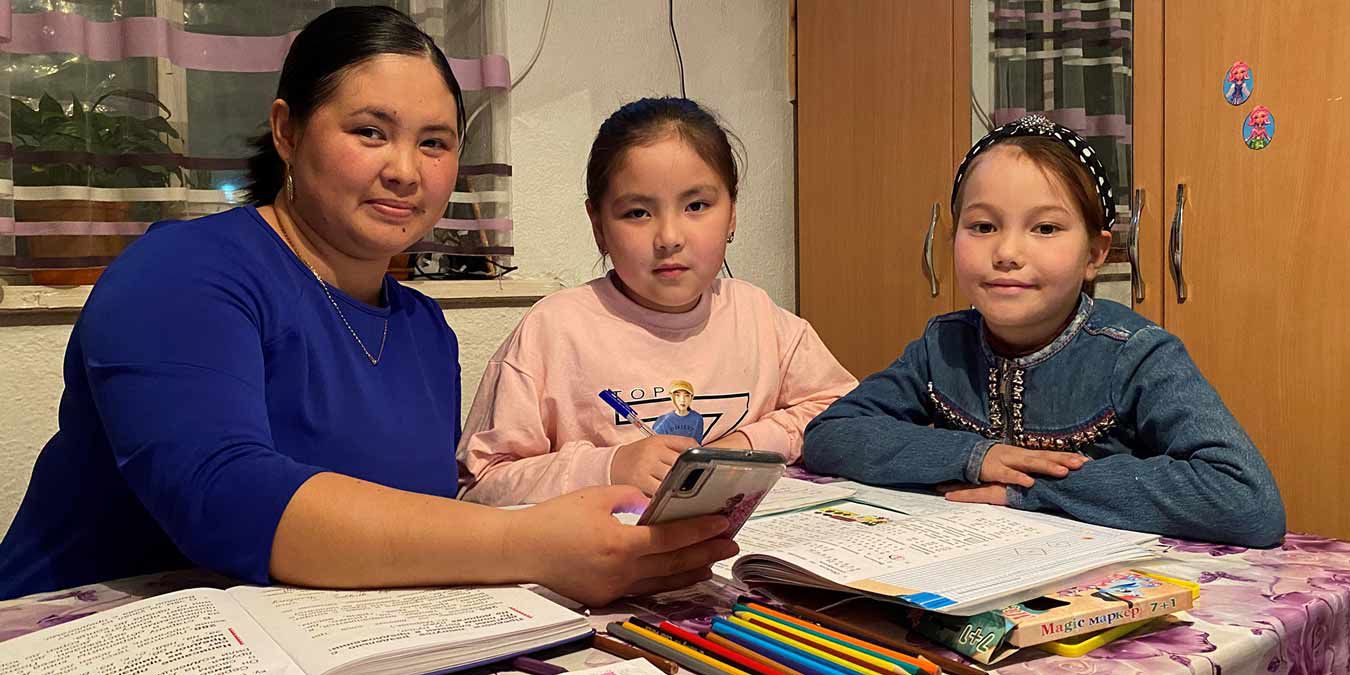- Internet connectivity and broadband speeds in the Kyrgyz Republic are well below the global average, with little or no internet in some remote areas.
- An IFC project will help build internet infrastructure and increase high-speed internet in underserved areas.
- Increases in broadband penetration boost GDP, according to World Bank research.
By Fran Brennan and Kymbat Ybyshova
Since COVID-19 shut down much of her village in the Kyrgyz Republic last March, Meerim Arunova has been trying to help her nine- and 10-year-old daughters manage online schooling without the benefit of a computer or internet connectivity. Using only her mobile phone and the few options accessible via television, Arunova does her best to keep the girls up to date on lessons and schoolwork while also managing the household and minding her five-year-old son, who hasn’t yet started school.
It has been a heavy load for her family and for many others, says Arunova, 32.
“The lack of necessary equipment for each child and a reliable internet connection has become a serious problem for many families in the Kyrgyz Republic,” Arunova says. “Many families get by with one smartphone for all children.”
A recent IFC investment is designed to help: a $3 million loan to ElCat, the nation’s largest private wholesale broadband operator, will allow the company to increase high-speed internet in underserved areas, some of which have no internet. Ulan Tolubaev, ElCat LLC’s Chief Executive Officer, says the company plans to use the IFC funding to expand its network and improve affordability and access to high-speed internet for households, businesses, and public entities, including schools, health-care centers and government offices—including in remote locations.
“We are confident that expanding the country’s telecommunications infrastructure will help to respond to the need for improved broadband networks, develop vital electronic services, and bring new economic opportunities,” Tolubaev says.
This could mean faster, more-reliable connectivity for homes, businesses, and public institutions—including schools—at a time when connectivity has never been more important for the landlocked country.
“Connectivity is the foundation you use to layer on all the additional services we see in the world today, whether it’s e-government services like health and education, payments to people who need them in far-flung locations, or if it’s the next level up—things like venture capital, e-commerce, e-logistics, and e-tourism,” says Baker Kiggundu, an IFC investment officer with the infrastructure team. “What we’re doing is we’re using technology to bypass the disadvantages of being landlocked, suddenly equalizing the game and giving people access to a lot of markets.”
This constitutes a big change for the Kyrgyz Republic, whose economy, health care, and education systems had been lagging in recent years. Its connectivity and broadband speeds are well below the global average, with little or no internet in some remote areas. Like many of its neighbors in Central Asia, the Kyrgyz Republic’s connectivity issues date far back into history, when the world discovered a route to China by sea and made the Silk Road—and the countries using it for trade—redundant. The landlocked region found itself falling further and further behind, with digital connectivity being one of the most recent casualties.
The ElCat loan is IFC’s first investment in the country’s digital infrastructure, and it required considerable entrepreneurial work and cross-World Bank Group cooperation to bring it to fruition. It grew out of a joint World Bank-IFC effort to identify countries with poor connectivity and then to use private-sector solutions whenever possible to address that, Kiggundu says. He worked closely with colleagues at the Bank on the Digital CASA (Central Asia-South Asia) – Kyrgyz Republic Project, a collaboration key to making the sector more attractive—and open—to private investment.
IFC Country Officer in the Kyrgyz Republic Manizha Mamadnabieva agrees and says this investment comes at a critical time.
“It has been a challenge,” she says of the country’s move to all-digital education, home office work, and more, especially in remote regions. “That’s why it was crucial to support the digital agenda in all areas—education, financial, government services, and even health care, which faced significant disruptions at the height of the crisis. People could be in contact with doctors through messaging apps and get guidance on what to do at the first sign of COVID.
“This is another example of how important digital communication has been. We believe this investment will lay a strong foundation for the country’s transition to the digital economy.”
World Bank studies support that: one study shows that a 10 percent increase in broadband penetration—not just fixed broadband but even mobile-phone connectivity—is estimated to increase a country’s overall GDP by 0.6 percent. In the Kyrgyz Republic, Kiggundu says, the current broadband penetration rate is about 40 percent.
“Essentially, there’s plenty of room to boost broadband penetration rates,” he says. “And this can have significant impact. The COVID crisis highlights why these networks are so important to a country’s resilience, especially amongst the most vulnerable communities.”
The pandemic has absolutely made internet connectivity more relevant—and more necessary—than ever , agrees Tolubaev.
Published in April 2021
